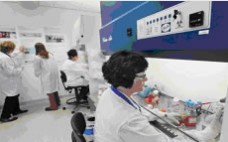Optimal formulation of peptide and protein pharmaceuticals into efficacious dosage forms to ensure sufficient stability and provide acceptable shelf life is critical. To achieve a stable pharmaceutical drug product, excipients are often added to the protein drug substance. In this study, we investigate recombinant human albumin (rAlbumin) for its ability to prevent or minimize physical and chemical degradation of two allelic variants of the recombinant malaria vaccine candidate, merozoite surface protein 2 (MSP2), in various test formulations. The studies establish…
Upstream Processing
Application of animal-free recombinant bioactive protein supplements to improve the performance of cell-based viral vaccine production
The development and regulatory approval of continuous cell lines for manufacturing viral vaccines has brought numerous benefits to production processes. We and others have contributed to upstream advances by improving cell culture media with the development of animal-free and chemically-defined recombinant protein supplements. The supplements developed include recombinant insulin-like growth factor-I (LONG®R3IGF-I), epidermal growth factor (LONG®EGF), transforming growth factor-α (LONG®TGF-α), transferrin (CellPrime™ rTransferrin AF), and albumin (CellPrime ™rAlbumin AF-G or -S). Extensive literature on the action of these bioactive proteins…
Working Toward Animal-Free Processing
Biological therapeutics is one of the fastest growing segments of the pharmaceutical industry — so much in fact that the overall cell culture media and supplements market used in bioprocessing applications is reportedly near $800 million (1). An increasingly important trend in cell culture is risk reduction throughout the supply chain, including a stringent focus on key raw materials. Accordingly, the industry has increasingly adopted animal-component-free materials to mitigate concerns over safety, transmissible spongiform encephalopathies, and other contaminations.…
Mixing in Small-Scale Single-Use Systems
Despite the advantages of presterile, single-use technologies, mixing is one of their most complex applications. Industry has been progressing toward using single-use bag technologies rather than traditional methods of stainless steel tanks and grades A/B processing because of the positive aspects they impart to end users, including a reduced potential for contaminants, cleaning, sterilization, and capital. These technologies offer simplicity and flexibility (1). However, using them for an operation such as mixing can add processing challenges. For example,…
Modeling Bioprocess Cost
At every stage of biopharmaceutical development, efficient and cost-effective protein production is critically important to maintaining the economic viability of both a product and the company developing it. Biopharmaceuticals have significantly evolved through recent protein engineering advances, resulting in highly complex, novel proteins dominating the development pipeline. Such proteins are by definition very difficult to express in a soluble and active form. The success of these products depends on accessing a platform that rapidly produces high-quality, properly folded,…
Global Material Harmonization for Increased Effectiveness and Reduced Risk
As geographic distances continue to metaphorically shrink, there is an increased focus on improving operational effectiveness. But, in order to increase effectiveness, it is important to understand and mitigate risk. In this on-demand webcast, Ben Locwin of Lonza Biologics demonstrates how material harmonization can help reduce risk and increase effectiveness by allowing:
• Use of one material specification
• Shared testing
• Shared raw material qualifications
• And more.
View this webcast to learn more about how synchronization of raw material testing can not only improve effectiveness, but reduce risk and lower costs as well.
Integrity Systems: A Comprehensive Toolkit for Single-Use Solutions
Single-use solutions are in growing demand within the biopharmaceutical manufacturing industry. With a complete line of solutions — from mixing systems to ultra-clean packaging — ATMI LifeSciences is a leader in these technologies. In this educational webcast, Jared Hisle, Global Product Manager at ATMI LifeSciences, explores the full line of Integrity™ Systems single-use technologies, including:
• NewForm™ Sterilizable Packaging
• Integrity™ Liquid and Powder Vessels
• Integrity™ Mixers
• Integrity™ Bioreactors
ATMI maintains the world’s largest installed base of single-use mixing systems and offers the world’s only single-use platform including film extrusion. Join Hisle as he demonstrates the advantages of ATMI’s single-use solutions.
Quality by Design (QbD): Defining Hydrolysates & Designing Quality
Complex. Undefined. Variability. These are all typical attributes that are used to describe protein hydrolysates because they are exactly that — complex, undefined and their performance may vary on a lot-to-lot basis. But despite all of the uncertainties, using hydrolysates as media supplements can stimulate cell growth and improve protein production — and ultimately lower the cost of goods tremendously. That is why the scientists at FrieslandCampina Domo have started the project “Defining Hydrolysates and Designing Quality.”
In this educational webcast, Dr. Jan Boots of FrieslandCampina Domo answers the questions — Can hydrolysates be defined? And can consistent quality be designed into them? Join Dr. Boots as he explores the complexity of hydrolysates and how Domo is working to define them.
Putting It All into Perspective
As part of The Automation Partnership’s “20 Years of Automated Cell Culture” series, science writer Sue Pearson interviewed Dr. John Birch, the chief scientific officer of biopharmaceuticals for Lonza Custom Manufacturing APIS based in Slough, UK. Birch has been with that company since 1996, Before that, he held senior technical positions at Tate and Lyle, GD Searle, and Celltech. Birch has a PhD in microbiology from London University, where he also spent a period lecturing before moving into…
Minimizing the Environmental Footprint of Bioprocesses
Biomanufacturers must take active measures to minimize their environmental footprints and promote environmental sustainability. The collateral benefit of reducing environmental footprint often is viewed as only a secondary consideration after cost of goods and product quality. Biopharmaceutical processes are 80% defined by the time of proof-of-concept studies (clinical trial stage 2b). This milestone is before the official technical transfer to commercialization or manufacturing organizations and almost always before the environmental evaluation of a production process. This step is…




